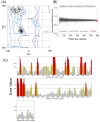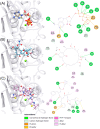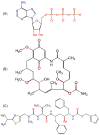Structural Characterization of Heat Shock Protein 90β and Molecular Interactions with Geldanamycin and Ritonavir: A Computational Study
- PMID: 39201468
- PMCID: PMC11354266
- DOI: 10.3390/ijms25168782
Structural Characterization of Heat Shock Protein 90β and Molecular Interactions with Geldanamycin and Ritonavir: A Computational Study
Abstract
Drug repositioning is an important therapeutic strategy for treating breast cancer. Hsp90β chaperone is an attractive target for inhibiting cell progression. Its structure has a disordered and flexible linker region between the N-terminal and central domains. Geldanamycin was the first Hsp90β inhibitor to interact specifically at the N-terminal site. Owing to the toxicity of geldanamycin, we investigated the repositioning of ritonavir as an Hsp90β inhibitor, taking advantage of its proven efficacy against cancer. In this study, we used molecular modeling techniques to analyze the contribution of the Hsp90β linker region to the flexibility and interaction between the ligands geldanamycin, ritonavir, and Hsp90β. Our findings indicate that the linker region is responsible for the fluctuation and overall protein motion without disturbing the interaction between the inhibitors and the N-terminus. We also found that ritonavir established similar interactions with the substrate ATP triphosphate, filling the same pharmacophore zone.
Keywords: Hsp9β; cancer; chemical ligations; drug repurposing; geldanamycin; molecular docking; molecular dynamics; ritonavir.
Conflict of interest statement
The authors declare no conflicts of interest.
Figures







Similar articles
-
Client Proteins and Small Molecule Inhibitors Display Distinct Binding Preferences for Constitutive and Stress-Induced HSP90 Isoforms and Their Conformationally Restricted Mutants.PLoS One. 2015 Oct 30;10(10):e0141786. doi: 10.1371/journal.pone.0141786. eCollection 2015. PLoS One. 2015. PMID: 26517842 Free PMC article.
-
Structure of the ATP-binding domain of Plasmodium falciparum Hsp90.Proteins. 2010 Oct;78(13):2738-44. doi: 10.1002/prot.22799. Proteins. 2010. PMID: 20635416 Free PMC article.
-
Spotlight on the microbes that produce heat shock protein 90-targeting antibiotics.Open Biol. 2012 Dec 12;2(12):120138. doi: 10.1098/rsob.120138. Open Biol. 2012. PMID: 23271830 Free PMC article. Review.
-
Posttranslational modification and conformational state of heat shock protein 90 differentially affect binding of chemically diverse small molecule inhibitors.Oncotarget. 2013 Jul;4(7):1065-74. doi: 10.18632/oncotarget.1099. Oncotarget. 2013. PMID: 23867252 Free PMC article.
-
Geldanamycin, radicicol, and chimeric inhibitors of the Hsp90 N-terminal ATP binding site.Curr Top Med Chem. 2006;6(11):1173-82. doi: 10.2174/156802606777812031. Curr Top Med Chem. 2006. PMID: 16842154 Review.
References
-
- Diniz C.S.G., Pellini A.C.G., Ribeiro A.G., Tedardi M.V., de Miranda M.J., Touso M.M., Baquero O.S., dos Santos P.C., Chiaravalloti-Neto F. Breast Cancer Mortality and Associated Factors in São Paulo State, Brazil: An Ecological Analysis. BMJ Open. 2017;7:e016395. doi: 10.1136/bmjopen-2017-016395. - DOI - PMC - PubMed
-
- Tilli T.M., Carels N., Tuszynski J.A., Pasdar M. Validation of a Network-Based Strategy for the Optimization of Combinatorial Target Selection in Breast Cancer Therapy: siRNA Knockdown of Network Targets in MDA-MB-231 Cells as an in Vitro Model for Inhibition of Tumor Development. Oncotarget. 2016;7:39. doi: 10.18632/oncotarget.11055. - DOI - PMC - PubMed
-
- Korsching E., Packeisen J., Liedtke C., Hungermann D., Wülfing P., van Diest P.J., Brandt B., Boecker W., Buerger H. The Origin of Vimentin Expression in Invasive Breast Cancer: Epithelial–Mesenchymal Transition, Myoepithelial Histogenesis or Histogenesis from Progenitor Cells with Bilinear Differentiation Potential? J. Pathol. 2005;206:451–457. doi: 10.1002/path.1797. - DOI - PubMed
MeSH terms
Substances
Grants and funding
LinkOut - more resources
Full Text Sources
Miscellaneous

